English Language Arts
for 3rd Grade Students
See what skills your child will learn in English Language Arts, examples of student work and how you can help at home.
Tip: Hover over icons to see definitions of key terms.
This is an example tooltip!

Expectations for Students
3rd graders should understand how to do the following well by the end of the year:
Learning to Read and Write
Match letters & sounds to decode
& write out most words.
Know & use suffixes
& prefixes
.
Write complete sentences & simple paragraphs about what they are learning, with mostly correct spelling, grammar, capitalization, & punctuation, including commas & apostrophes.
Independently read grade-level texts (Lexile 420–820, F&P: F–M, DRA: 12-38) fluently & with expression. Students should read 80-140 words per minute & should understand what they are reading.
Learning About the World Through Text
Ask & answer questions about stories & texts read independently. Retell what happened, explain & connect key ideas. Show examples from the text that supports their thinking.
Figure out the meaning of unknown words by using pictures, context, glossaries, etc. Figure out words with multiple meanings or figurative language.
Use linking words to connect ideas (such as “also,” “another,” “first,” “more,” “but”).
Write about what happened or information learned from the text. Include a title, an introduction, well-developed examples, & a conclusion.
3rd Grade English Language Arts Examples
What is Light?
Did you know that the sun is the greatest source of light for our planet, Earth? But what is light? Why is it so important? Hot gasses of the sun give off both light and heat energy. Light carries energy, with the long wavelengths carrying the least and the short wavelengths carrying the most. When you think of something with lots of energy, what comes to mind? Do you think of something fast like a race car? Do you think of something with great force like a very strong wind knocking down a tree? Believe it or not, light can be many times more energetic than a car or the wind.
Light travels at 186,000 miles every second in a vacuum. At that speed, light can go around Earth more than seven times every second! No human-made machine can go that fast—not even a jet plane or rocket! One way that light travels, including light from the sun, is in the form of waves. Scientists can measure how long light waves are.Waves can be different sizes—some are long and some are short. Some light waves are visible and some are invisible. Whether you can see light or not depends on the length of the wave. The longest wavelength of visible light is seen as red and the shortest wavelength is violet. Short wavelengths carry the most energy.
The sun gives off what is called white light. Perhaps you think of the light from the sun as having no color at all. Maybe you think the light from the sun is more yellow in color. It may surprise you to know that the sun’s light, white light, is made up of all the colors of the rainbow. White light includes light of different wavelengths, including all the colors we can see. Of all the wavelengths in the sun’s light, there is just a little more of the yellow wavelengths than the other colors. This is why the sun looks yellow when we see it against the blue sky. Still, the light from the sun includes all of the other colors and wavelengths..
Although the sun is the greatest source of visible light, there are also other sources of light. What else in the sky provides light? The other stars in the night sky provide light, though it is not as bright as the light from the sun during the day. The moon is not a star and does not give off its own light. Can you think of other sources of light? Is there light in your classroom right now? Perhaps it is from the sun shining through the windows. Chances are good, though, that some of the light in the room may be coming from light
bulbs. Like the sun, most light bulbs give off white light. Electric lights are such a part of our everyday life, we don’t even think about them—unless the electricity goes off! This doesn’t happen often, but sometimes it does during a bad storm. When the electricity goes off and we do not have light from light bulbs, people sometimes use other sources of light, like flashlights or candles.
Light is important for many reasons. Light and heat energy from the sun warms Earth. Without the light and heat energy from the sun, Earth would be freezing cold. You also learned back in kindergarten that the sun’s light is needed for plants to grow. Also, without light, there would be no colors. Can you think of another reason that light is important? Try to imagine a world in which there is no light— no sun, no stars, no candles, and no light bulbs. What would be different? If you just said that it would be dark, you are only
partly right. What else would change? Without light, you would not be able to see anything! A world without light is almost impossible to imagine.1
The Abenaki
The Abenaki lived in Vermont in the early 1600. The Abenaki are a group of native people . They lived here much before you & me they learned how to dell with the land. There were no houses no electricity not even heating the land had hills moutain lots of trees rivers. Vermont’s land affected the early Abenaki’s housing & their food.
Vermont’s land affected the Abenaki’s housing . The Abenaki used young trees to build their houses. They cut it down & then bent it into a round roof. This kept the Abenaki warm in the winter because the roof kept the warmth in. Vermont’s land also had lots of animals. They skinned the animals & took their sinews the sinews held held the saplings together. This helped the Abenaki people keep their houses stable. Vermont’s land also had lots of trees. They used the bark from the trees to tie on the frame like singles . That helped the Abenaki the rain out so they staid dire all the time. The Abanaki’s housing was greatly affected by the land.
Not only dose the land affect the Abenaki’s housing but it also affected the Abenaki’s food to. The Abenaki women picketed seeds in the forest. Then they planted them in some fresh soil. This helped the Abenaki because they had their own gardens & they planted seeds & soon they had food. Vermont’s land also had alot of fish. They killed the fish & the dead fish helped fertilize the soil. That gave the Abenaki extra food. Vermont’s land also had abundant wild life. The Abenaki fished & hunted game. All of the fresh meat was shard among the whole village to keep everybody strong. The Abenaki’s food supply was affected by the land.
Vermont’s land affected the early Abenaki’s housing & their food. The land seems to be a tough place to live but the Abenaki respited the land & only took what they needed & the land gave them what they needed .
Introduces a topic by providing some context & stating a focus
Groups related information together in paragraphs to organize each major part of the essay (housing, food)
Groups related information together in paragraphs to organize each major part of the essay (housing, food)
Develops the topic with facts
& details
Uses linking words & phrases to connect ideas within categories of information
Provides a concluding section that restates the main point & reflects on the significance of the information provided
Everyday Activities to Support Learning
Tips for Talking to Teachers
A strong relationship between families and teachers is key to ensuring students have what they need to succeed. Parent involvement not only leads to higher grades and test scores, but also helps students develop self-confidence, motivation, and social skills. Knowing what questions to ask at school visits and parent-teacher conferences can help you feel confident when it comes to addressing your child’s’ academic needs.

